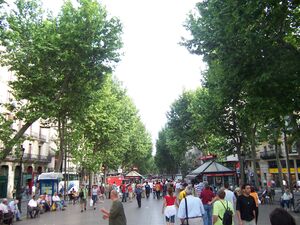2017 Barcelona attacks
 Las Ramblas a few years before the attack | |
| Location | La Rambla, Barcelona, Catalonia, Spain, Cambrils |
|---|---|
| Type | Vehicle-ramming attack |
| Deaths | 13 |
| Injured (non-fatal) | 130 |
On the afternoon of 17 August 2017, 22-year-old Younes Abouyaaqoub drove a van into pedestrians on the pedestrianized main street La Rambla in Barcelona, Catalonia, Spain killing 13 people and injuring at least 130 others, one of whom died 10 days later on 27 August. Abouyaaqoub fled the attack on foot, then killed another person in order to steal the victim's car to make his escape.[1][2][3]
Despite intense surveillance and the CNI’s own admission that Es-Satty was their informant, he was able to prepare the attacks totally undetected.
Nine hours after the Barcelona attack, five men thought to be members of the same terrorist cell drove into pedestrians in nearby Cambrils, killing one woman and injuring six others. All five of those attackers were shot and killed by police.[4]
The night before the Barcelona attack, an explosion occurred in a house in the Spanish town of Alcanar, destroying the building and killing two members of the terrorist cell, including the 40-year-old imam Abdelbaki Es Satty, thought to be the mastermind.[5] The home had more than 120 gas canisters inside which police believe the cell was attempting to make into one large bomb (or three smaller bombs to be placed in three vans which they had rented) but which they accidentally detonated.[6][3]
The Prime Minister of Spain, Mariano Rajoy, called the attack in Barcelona a jihadist attack.[7] Amaq News Agency attributed indirect responsibility for the attack to the Islamic State of Iraq and the Levant (ISIL).[8] The attacks were the deadliest in Spain since the March 2004 Madrid train bombings and the deadliest in Barcelona since the 1987 Hipercor bombing.[9] Younes Abouyaaqoub, the driver of the van in the Barcelona attack, was killed by police in Subirats, a town 30 miles (48 km) west of Barcelona on 21 August. The attackers flew under the radar, catching European intelligence agencies totally by surprise when they attacked.
Público
In July 2019, the Spanish newspaper Público published a four-part report after a year-long investigation into relations between Imam Abdelbaki Es-Satty, the leader of the terror cell, and the National Intelligence Centre (CNI). The investigation provided powerful evidence that the Spanish government, which was publicly seeking a pretext to impose martial law before the October 2017 declaration of Catalan independence, knew a terror cell existed in Barcelona but decided not to act to dismantle it. The investigation, met with a "conspiracy of silence" from other corporate media, revealed[10]:
- The CNI recruited Es-Satty as an informer at least as far back as 2014, using a Gmail account for communications between Es-Satty and his CNI handler.
- The intelligence services falsified his legal files to prevent his expulsion after he was found guilty of drug-trafficking. He even received aid from the CNI to install him as an Imam in the small Catalan town of Ripoll, although he was known to have been radicalised for a long time, as far back as 2004, when he was linked to the attacks in Casablanca on 16 May 2003.
- The CNI wiped Es-Satty’s record so that Ripoll’s Muslim community would not be aware of his history; this also hindered Catalan regional police as they began to investigate the attacks.
- The CNI knew the movements of some of the cell’s members in France, Germany, Belgium and Switzerland, and monitored phone conversations between them. Es-Satty had contacts with Islamist forces across Europe involved in the NATO-led proxy war against Syria, including jihadist circles in Belgium. The CNI’s intense monitoring of his cell required the collaboration of European intelligence agencies, including French intelligence, which has acknowledged that it spied on members of Es-Satty’s cell who travelled to Paris shortly before the Barcelona attack.
- The CNI devoted an extraordinary level of surveillance to members of the cell, including those who had no criminal record until the day of the attacks. The CNI, Público writes, was “listening to and transcribing all conversations between those young Muslims, who were not supposedly yet related to any jihadist plot—executing the most exhaustive possible intelligence controls, which require considerable material and human resources.”
- After the attack, CNI officers involved in dealing with Es-Satty were posted to a remote African country, and another was “moved to the capital of a Latin American country with his family.”
Driss Oukabir was arrested after his passport was discovered at the scene of the 2017 Barcelona attack. He stated that it had been stolen.[11]
References
- ↑ https://www.bbc.co.uk/news/world-europe-40973119
- ↑ https://www.bbc.com/news/world-europe-40998300
- ↑ a b https://www.theguardian.com/world/2017/aug/21/police-searching-barcelona-van-driver-shoot-man
- ↑ https://www.theguardian.com/world/2017/aug/17/van-crashes-into-crowd-of-people-barcelona-las-ramblas
- ↑ http://www.elmundo.es/cataluna/2017/08/21/599a8830e5fdea921e8b4576.html
- ↑ https://www.bbc.com/news/world-europe-40990927%7C
- ↑ https://www.bbc.com/news/world-europe-40975552
- ↑ https://www.reuters.com/article/us-spain-barcelona-idUSKCN1AX1W6
- ↑ Cite error: Invalid
<ref>tag; no text was provided for refs namedeco - ↑ https://www.wsws.org/en/articles/2019/09/10/pub1-s10.html
- ↑ https://www.theguardian.com/world/2017/aug/18/terror-timeline-of-barcelona-and-cambrils-attacks-and-other-terror-raids